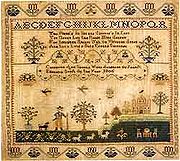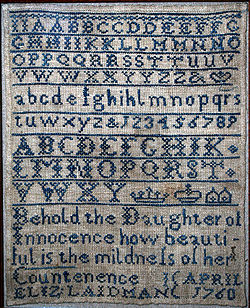
Sampler (needlework)
Encyclopedia


Embroidery
Embroidery is the art or handicraft of decorating fabric or other materials with needle and thread or yarn. Embroidery may also incorporate other materials such as metal strips, pearls, beads, quills, and sequins....
produced as a demonstration or test of skill in needlework
Needlework
Needlework is a broad term for the handicrafts of decorative sewing and textile arts. Anything that uses a needle for construction can be called needlework...
. It often includes the alphabet, figures, motifs, decorative borders and sometimes the name of the person who embroidered it and the date. The word sampler is derived from the Latin ‘exemplum’ - an example.
History
The oldest surviving samplers were constructed in the 15th and 16th centuries. As there were no pre-printed patterns available for needleworkers, a stitched model was needed. Whenever a needlewoman saw a new and interesting example of a stitching pattern, she would quickly sew a small sample of it onto a piece of cloth - her 'sampler'. The patterns were sewn randomly onto the fabric as a reference for future use, and the woman would collect extra stitches and patterns throughout her lifetime.16th Century English samplers were stitched on a narrow band of fabric 6–9 in (152.4–228.6 mm) wide. As fabric was very expensive, these samplers were totally covered with stitches. These were known as band samplers and valued highly, often being mentioned in wills and passed down through the generations. These samplers were stitched using a variety of needlework styles, threads, and ornament. Many of them were exceedingly elaborate, incorporating subtly shaded colours, silk
Silk
Silk is a natural protein fiber, some forms of which can be woven into textiles. The best-known type of silk is obtained from the cocoons of the larvae of the mulberry silkworm Bombyx mori reared in captivity...
and metallic embroidery
Embroidery
Embroidery is the art or handicraft of decorating fabric or other materials with needle and thread or yarn. Embroidery may also incorporate other materials such as metal strips, pearls, beads, quills, and sequins....
threads, and using stitches such as Hungarian, Florentine, tent, cross, long-armed cross, two-sided Italian cross, rice, running, Holbein
Holbein stitch
Holbein stitch is a simple, reversible line embroidery stitch most commonly used in Blackwork embroidery and Assisi embroidery. The stitch is named after Hans Holbein the Younger , a 16th-century portrait painter best known for his paintings of Henry VIII and his children, almost all of whom are...
, Algerian eye and buttonhole stitches. The samplers also incorporated small designs of flowers and animals, and geometric designs stitched using as many as 20 different colors of thread.

The earliest dated surviving sampler, housed in the Victoria and Albert Museum
Victoria and Albert Museum
The Victoria and Albert Museum , set in the Brompton district of The Royal Borough of Kensington and Chelsea, London, England, is the world's largest museum of decorative arts and design, housing a permanent collection of over 4.5 million objects...
in London
London
London is the capital city of :England and the :United Kingdom, the largest metropolitan area in the United Kingdom, and the largest urban zone in the European Union by most measures. Located on the River Thames, London has been a major settlement for two millennia, its history going back to its...
, was made by Jane Bostocke who included her name and the date 1598 in the inscription. However, the earliest documentary reference to sampler making is recorded in 1502 The household expense accounts of Elizabeth of York
Elizabeth of York
Elizabeth of York was Queen consort of England as spouse of King Henry VII from 1486 until 1503, and mother of King Henry VIII of England....
record that:
'the tenth day of July to Thomas Fisshe in reward for
bringing of concerve of cherys from London to Windsore ... and for an elne of Iynnyn cloth for a sampler for the Quene'.
A border was added to samplers in the 17th century, and by the middle of the 17th century alphabet
Alphabet
An alphabet is a standard set of letters—basic written symbols or graphemes—each of which represents a phoneme in a spoken language, either as it exists now or as it was in the past. There are other systems, such as logographies, in which each character represents a word, morpheme, or semantic...
s became common, with religious or moral quotations, while the entire sampler became more methodically organised. By the 18th century, samplers were a complete contrast to the scattered samples sewn earlier on. These samplers were stitched more to demonstrate knowledge than to preserve skill. The stitching of samplers was believed to be a sign of virtue, achievement and industry, and girls were taught the art from a young age.
Current situation
Samplers are widely stitched today, some using kits purchased from needlework shops, some from chart-packs, and many from patterns available on the Internet or through e-mail from designers. Patterns range from simple using only one stitch, to complex, using 15 to 20 and more stitches. Designs range widely in style, from accurate reproductions of historic pieces to much more contemporary and modern styles. Many sampler reproductions are also available, copying colors and imperfect stitches from the originals.Materials used include aida cloth
Aida cloth
Aida cloth is an open weave, even-weave fabric traditionally used for cross-stitch embroidery. This cotton fabric has a natural mesh that facilitates cross-stitching and enough natural stiffness that the crafter does not need to use an embroidery hoop....
, evenweave, and linen fabrics, in cotton, linen, and man-made materials combined in more and more ways; and fibers from cotton floss to silk, rayon, viscose, and metallic.
External links
- A brief history of embroidery samplers
- Sampler history and design
- Old Sampler - Virtual Museum of Textile Arts
- Images of samplers from the collection of the Museum of New Zealand Te Papa Tongarewa
- Samplers at the Victoria and Albert Museum
- Victoria and Albert MuseumVictoria and Albert MuseumThe Victoria and Albert Museum , set in the Brompton district of The Royal Borough of Kensington and Chelsea, London, England, is the world's largest museum of decorative arts and design, housing a permanent collection of over 4.5 million objects...
Sampler story; Textiles - Some More Modern Examples

